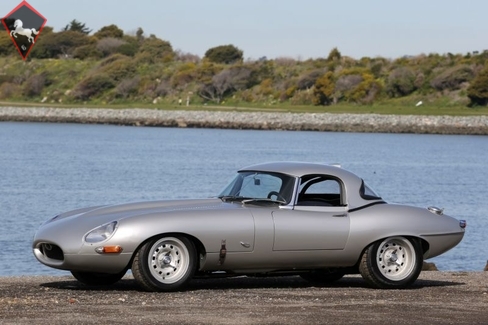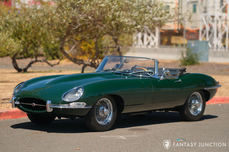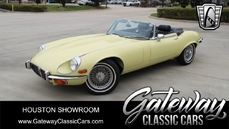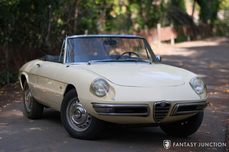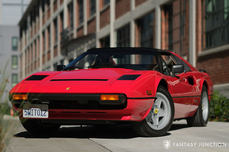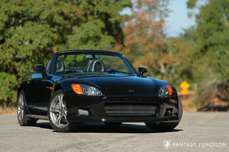Jaguar E-type 4.2 liter inline-6 no. 8L148468-S 1965
Allgemeine Beschreibung :
1965 Jaguar E-Type Lightweight #11 Recreation
s/n 1E10022 engine no. 8L148468-S
Opalescent Silver with Black Interior
When Jaguar unveiled the E-Type at the 1961 Geneva Motor Show, everything in the sports car world was about to change. Stunning design, unrivaled performance, cutting edge technology, and racing lineage made the E-Type an immediate sensation. The beautiful lines and attractive pricing made the E-Type highly desirable for road use, but on the racetrack, Jaguar delivered again with top performance. Standard cars were raced regularly by privateers, but it was the factory lightweight cars that achieved the most renown. Comprehensively remanufactured in aluminum and fitted with race upgraded mechanical components from end to end, the E-Type Lightweight is now a legend. Aesthetically, the car was transformed as well: bumpers were removed, the rear fenders were expanded to accommodate purposeful Dunlop alloy wheels, and extractors were added to the hardtop and trunk lid. Just 12 examples were built and the cars remain among the most desirable Jaguar cars ever made.
While the lightweight resembles a standard E-Type, changes were substantial, and building an authentic recreation of one is extraordinarily involving. This no expense spared recreation is a testament to the dedication and enthusiasm of its builders and is a stunning tribute to the legendary E-Type Lightweight. Built to impeccable standards by top fabrication specialists over a eight year period, this car is closely patterned after the 11th Lightweight built, first registered 2GXO in London in 1963.
According to the Jaguar Heritage Trust Certificate, this car, chassis #1E10022 was produced in August 1964 and originally finished in cream with dark blue interior. This roadster came under long-term ownership in the 1980s until it was sold in 1995 to a Jaguar enthusiast who appreciated how straight and solid it was. Retaining its matching numbers engine, the car was at this time red, and its owner drove it for about three years, during which time he embarked on a personal quest to fastidiously research and document as many details as possible regarding the E-Type Lightweights. By 1998, he had reached the ultimate decision point and decided to embark on a build to recreate, as faithfully as possible, 2GXO.
He began by carefully disassembling the entire car, photographing and cataloging his efforts along the way. In 1999, Jaguar expert Steve Helms media blasted the entire shell and the metal work began. In April 2000, an order was placed with Dunford Limited, UK for all aluminum panels to be fabricated by master craftsmen. The order included two doors, a hardtop, a complete bonnet, boot lid, rear quarter panels, and boot/hardtop panel vents to replicate those of 2GXO. At this time Dunlop racing wheels, hubs and a variety of other specific Lightweight parts and pieces were purchased totaling nearly $20,000. Between 2003-2005, and additional $36,000.00 was spent with a local aluminum fabrication specialist to shape and contour the panels, fit them to the monocoque, and prep the car for paint. Jaguar monocoque experts Lindley Motors then completed the final paint prep, paint, and finishing for re-assembly. In September 2005, the body and frame was completed to show quality finish, ready for Steve Helms to re-assemble.
The details of the engine were recreated using the original specifications and period blue prints. The original engine was set aside and left undisturbed (and is included with the car), and a newer 4.2 liter XJ6 engine procured specifically because of its larger oil galleys and other updates, making it well suited to being built up to produce more power when compared to the original E-Type engine. E-Type race engine specialists Hyde Villa Machine Shop in Reading, PA were commissioned to build the engine. A few details of the extensive rebuild include a balancing and blue printing, porting and polishing, Venolia +.020 pistons, new rods, Isky race cams, aluminum fly wheel, 3 Weber DCOE 45 152 carburetors, AP clutch, stainless steel headers, and stainless steel exhaust. Only the finest components were utilized, making a performance engine that would readily and reliably perform safely on pump gas, but even better on racing fuel. A detailed specification sheet with parts totaling over $10,000.00 is included in the records with this car. Despite the competition-oriented build, the engine is impressive tractable and well-mannered. Additionally, with the original engine (included with the car) refitted, the car would be eligible for FIA European vintage racing.
Once the engine was completed, the suspension and braking system were tended to with the same attention to detail. Willwood brakes and Spax shocks were installed as well as upgraded suspension bushings, and stainless steel brake lines and adjustable torsion bar reaction plates. Further sorting continued to the exterior of the car installing a LeMans filler cap, finishing the extractor vents, correct roll bar, and other supporting details. The build was completed in 2006, with minor sorting and maintenance performed during the years since the car’s completion.
Today, the car presents as a spectacular authentic Lightweight with both impressive presence and excellent finishes throughout. The paint was done to a very high standard, with excellent gloss and consistent coverage throughout. There are some minor paint blemishes, including light scuffing under the nose, a ¼” paint blemish on the drivers side quarter panel, and a few minor chips that have been touched up. Panel fit and gaps are excellent in all aspects with proper rubber components tightly fitting and correctly finished aluminum trim strips in place of the bumpers. The lighting, lenses, and windshield are in excellent condition with exceptional attention to the leather bonnet and boot latches, properly trimmed exterior features, and of course the gorgeous staggered wheels and tires which contribute perfectly to the hunkered down racing profile of this fine recreation. Further in keeping with the competition build, the side and rear glass has been replaced with lighter weight lexan.
The interior of the car is as carefully thought out and detailed as the exterior. Opening the aluminum doors, one immediately feels the lightness as an invitation to the competition-inspired interior. Aluminum seats are wrapped in supple black leather accompanied by 4-point seat harnesses, exposed central tunnel, minimal carpeting, and beautifully riveted roof vent in the headliner. The look and feel is precise but vintage, with just enough comfort and elegance conveying a purposeful build that remains streetable. The leather wrapped steering wheel and beautifully finished black dashboard feature an array of E-Type instruments, which have all been rebuilt by Nisonger, including a rare 6,500 rpm tachometer, specific to Lightweight cars. The trunk is spartan, but is as nicely finished as the rest of the car with a black Ambla mat and spare wire wheel with tire.
Lifting the lightweight aluminum hood, the engine and exceptionally well-detailed engine bay reveals beautiful finishes and proper attention once again to the competition history in homage to the original. The view is dominated by the triple Weber carburetors, while further inspection reveals the beautifully finished aluminum radiator and header tank. A Coolcats electric fan is also fitted. The engine is very well conceived and built with proper features including proper cabin ducting, wiring, and other details, all of which are finished to very high standards. Further delightful features include polished cam covers, stainless exhaust, beautifully hued from use, and finely finished suspension. The underside of the car is very clean, nicely sorted, and remains nicely detailed throughout. The workmanship, fit, and finish are exemplary in the chassis and components, reflecting a cohesive and exceptional build.
Nestling inside the interior, turning the key energizes the electrical system and the fuel pump clicks, rapidly at first, and then slows as fuel pressure builds. Depressing the starter button ignites the twin cam engine, which is snappier and more aggressive than stock, but still tractable and streetable. Throttle response is excellent, and the engine has a balanced, smooth feeling. The exhaust sound and induction noises from the Webers are magnificent. The increased power and reduced weight provide explosive acceleration that represents a dramatic difference against a standard E-Type. The gearbox is a full synchro unit from 1965 and works very smoothly, with a slickness that is not usually present in these gearboxes. The leather rimmed steering wheel and larger wheels give a substantial feel to the steering that inspires the driver’s confidence and telegraphs the increased grip available from the wider front tires. The suspension provides more precise handling and reduced body movement but remains compliant and comfortable for street use. The overall driving experience is thrilling and evocative, but not so raw as to preclude comfortable street use. The noise level inside the car is suitable for touring, heat levels in the car are properly managed, and the controls, including the clutch, have a linear, progressive operation. A host of spares is included with the car along with the original engine, records supporting the fabrication, parts listing, and services performed on the car.
This exceptional Lightweight recreation represents the ideal blend of stunning presence, authentic aesthetics, and upgraded but still street-friendly performance. A fastidiously and enthusiastically built example that beautifully captures the essence of the ultimate E-Type, this car reflects the vision and dedication of its builder and the expert teams that built it.
http://fantasyjunction.com/cars/2090-Jaguar-E-Type%20Lightweight%20%20%20%20%20%20%20%20Replica-4.2%20liter%20inline-6
1965 Jaguar E-type 4.2 liter inline-6 no. 8L148468-S is listed verkauft on ClassicDigest in Emeryville by Fantasy Junction for $198500.
Fakten der Auto
Karosserietyp : Auto Marke : Jaguar Modell : E-type Ausführung : 4.2 liter inline-6 no. 8L148468-S Hubraum : 4.2 Modelljahr : 1965 Lage : Emeryville
Verkauft
Angaben Zum Verkäufer
Verkauft
People who viewed this Jaguar E-type also viewed similar Jaguar listed at ClassicDigest
Other cars listed for sale by this dealer
über Jaguar
Ah, die Geschichte von Jaguar, von seinen Anfängen als SS Cars Ltd. bis hin zum Höhepunkt mit dem D-Typ und der Straßenversion des ikonischen E-Typs. An dieser Erzählung haftet etwas zutiefst Britisches, und ich werde sie erzählen, wie es ein britischer Journalist tun würde.Die Anfänge:
Unsere Reise in die Welt von Jaguar beginnt in den 1930er Jahren, als ein Unternehmen namens SS Cars Ltd. auftauchte. Trotz des unglücklichen Zufalls ihrer Initialen, die mit den aufkommenden politischen Spannungen in Europa zusammenfielen, begannen sie, stilvolle und leistungsorientierte Autos herzustellen. Der SS 100, der 1936 eingeführt wurde, war ein Symbol für Eleganz und Geschwindigkeit und legte den Grundstein für das, was Jaguar werden sollte.
Die Geburt von Jaguar:
Als der Schatten des Zweiten Weltkriegs näher rückte, entschied sich SS Cars Ltd. klugerweise, sich von den SS-Initialen zu distanzieren. So wurden sie 1945 offiziell zu Jaguar Cars Ltd., ein Name, der bald für britischen Luxus und Leistung stehen würde.
Die XK-Serie:
Die Nachkriegszeit von Jaguar brachte uns den XK 120, eine wahre Sensation im Jahr 1948. Mit seinem schlanken Design und einem leistungsstarken 3,4-Liter-Sechszylindermotor wurde er zum schnellsten Serienauto der Welt. Der XK 120 war die Blaupause für das, was kommen würde - Jaguars, die Stil mit Geschwindigkeit auf einzigartig britische Weise verbanden.
Die Dominanz des D-Typs:
Dann kam der D-Typ, eine wahre Rennlegende. 1954 eingeführt, gewann er in den 1950er Jahren dreimal Le Mans und zeigte die technische Kompetenz von Jaguar. Mit seiner innovativen Monocoque-Konstruktion und der ikonischen Finne hinten war der D-Typ der Höhepunkt von Jaguars Motorsporterfolgen.
Das Auftauchen des E-Typs:
Aber der wahre Wendepunkt kam 1961 mit der Einführung des E-Typs, oft von Enzo Ferrari als "das schönste Auto, das je gebaut wurde" bezeichnet. Seine lange Motorhaube, die geschwungene Karosserie und ein 3,8-Liter-Motor, der atemberaubende Leistung lieferte, machten ihn sofort zu einem Klassiker. Der E-Typ war nicht nur ein Auto; er war ein Kunstwerk auf Rädern und konnte auf der Straße 150 Meilen pro Stunde erreichen.
Straßen- und Rennsporterfolge:
Die Schönheit des E-Typs wurde durch seine Leistung auf der Rennstrecke unterstrichen. Die leichten E-Typen waren bei verschiedenen Rennveranstaltungen besonders erfolgreich und festigten den Ruf von Jaguar als eine Kraft, mit der man im Motorsport rechnen musste.
Das Zeitalter der Raffinesse:
Je tiefer wir in die Geschichte von Jaguar eintauchen, desto mehr erkennen wir, dass die 1950er und 1960er Jahre ein Zeitalter der Raffinesse und Expansion waren. Neben dem großartigen D-Typ und dem ikonischen Aufstieg des E-Typs führte Jaguar Modelle ein, die seinen Ruf für Luxus und Leistung weiter festigten.
Der MK2:
Ende der 1950er Jahre stellte Jaguar den MK2 vor, eine Sportlimousine, die Eleganz mit Leistung vereinte. Diese elegante viertürige Limousine war sowohl bei Bankräubern als auch bei der Polizei aufgrund ihrer außergewöhnlichen Geschwindigkeit und Handhabung beliebt. Der MK2 war ein Symbol für Jaguars Fähigkeit, Raffinesse mit Leistung zu verbinden und hatte auch eine erfolgreiche Rennkarriere.
Der XJ6:
Springen wir ins Jahr 1968, als Jaguar ein Auto auf den Markt brachte, das Jahrzehnte lang Luxuslimousinen definieren würde - den XJ6. Es war ein Meisterwerk der Ingenieurkunst und des Designs, mit einem sanften Reihensechszylindermotor, unabhängiger Hinterachse und einem geräumigen, wunderschön ausgestatteten Innenraum. Der XJ6 war ein Symbol britischer Eleganz und bot eine so sanfte Fahrt, dass es schien, als würde er förmlich über die Straße gleiten. Er wurde zum Flaggschiffmodell für Jaguar und setzte den Maßstab für Luxuslimousinen und zeigte ein Maß an Raffinesse, das die Konkurrenz staunen ließ.
Die Verschmelzung von Klassik und Moderne:
Während der MK2 und der XJ6 die Evolution der Limousinen von Jaguar repräsentierten, bewahrten sie das Engagement der Marke für Leistung und Luxus. Diese Autos gehörten nicht nur auf die Rennstrecke; sie fühlten sich genauso wohl auf den Prachtstraßen wie auf einer entspannten Fahrt durch die englische Landschaft.
Die Herausforderungen des Wandels:
Dennoch sah sich Jaguar mit dem Eintritt der 1970er Jahre, wie viele britische Automobilhersteller, finanziellen Herausforderungen und Veränderungen in der Eigentümerschaft gegenüber. Die Ära von British Leyland brachte sowohl Chancen als auch Schwierigkeiten mit sich, während die Marke durch verschiedene Fusionen und Übergänge navigierte.
Das Erbe des MK2 und des XJ6, zusammen mit dem D-Typ und dem E-Typ, definiert Jaguar weiterhin als einen Hersteller, der zeitlose Eleganz mit einer Leistungsstärke vereint. Diese klassischen Modelle, ob sie über kurvige Straßen gefahren oder als Sammlerschätze geparkt werden, dienen als Zeugnis für die anhaltende Präsenz von Jaguar in der Welt der automobilen Exzellenz.
Die Jaguar-Geschichte, von ihren Anfängen als SS Cars Ltd. bis zur Schaffung von Automobilikonen wie dem E-Typ, dem MK2 und dem XJ6, ist eine Reise, die das Wesen des britischen Automobilbaus widerspiegelt - eine Mischung aus Luxus, Leistung und Stil, die nach wie vor Enthusiasten und Kenner gleichermaßen fasziniert.
